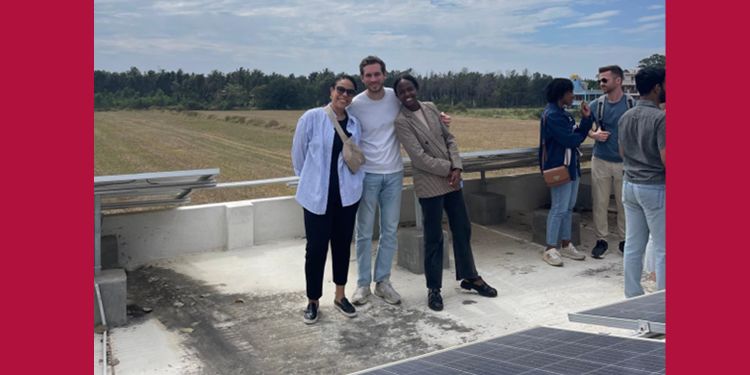Professor Vikram Gandhi’s Immersive Field Course (IFC) “Development while Decarbonizing: India’s Path to Net-Zero" delved into the critical aspect of decarbonization and sustainability goals amid India's rapid development. The course presented an opportunity for students to advance their knowledge of sustainability efforts, decarbonization, and net zero in the context of a broader development agenda. The class culminated in a series of site visits in January 2025 in Mumbai and Bangalore and this is one of 9 student essays that highlights their reflections on uncovering sustainable solutions across the country.
On the final day of the India IFC, we visited a rural public health clinic powered by SELCO’s decentralized renewable energy (DRE) solutions. The SELCO team also graciously organized a gathering of local entrepreneurs who are building their businesses using solar- powered technologies. Over our ten days in India, we explored numerous decarbonization solutions, but for true climate action to succeed in India, it must be inclusive. SELCO is achieving this by using DRE to catalyze economic development through contextualized solutions for India’s most marginalized populations.
SELCO’s Approach
SELCO is a social enterprise that operates with a mission to make energy access equitable and transformative through microgrids. The organization’s approach revolves around three core principles: decentralization, democratization, and disruption. SELCO designs and implements need-based solar energy systems tailored to the unique requirements of rural communities. These systems are co-created with stakeholders, including local NGOs and end- users, ensuring effectiveness and longevity.
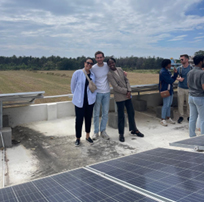
This collaborative ethos was evident in our conversations with the SELCO team during our visit. A hallmark of SELCO’s innovation process is a thorough understanding of the “problem statement” for each solution. From this foundation, they craft appropriate, affordable solutions powered by DRE to address the specific needs of these rural communities. Their goal is not only to solve these challenges locally but also to scale and amplify successful models to other regions.
As SELCO moves solutions from innovation to scale, they engage a diverse network of ecosystem stakeholders, including governments, financial institutions, development organizations, and cooperatives. One of their key collaborators are State Rural Livelihood Missions (SRLMs), which work with Self- Help Groups (SHGs) across India to rollout sustainable livelihood activities.
Operating primarily in Karnataka, Odisha, and the North Eastern regions of India, SELCO tailors its interventions to the socio-economic and geographical realities of each area. This adaptability ensures that their innovations are relevant and impactful.
Livelihood Activities
SELCO’s energy solutions are deeply embedded in livelihood activities, enabling communities to mechanize and develop in a “green and clean” way. From crafts to agriculture, SELCO’s innovations empower underserved groups, including women and people with disabilities, to build resilient micro businesses, promoting both poverty alleviation and climate adaptation.
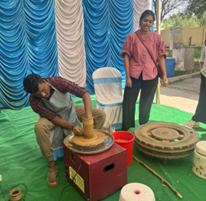
At the entrepreneurs’ fair organized by SELCO, we witnessed various livelihood solutions in action. A craftsman demonstrated the efficiency of his solar-powered pottery wheel, while community cooks showcased machines for roti making, chakli (snack) processing, sugarcane juice pressing, and vegetable chopping. These tools for higher productivity are all designed to be and are powered by SELCO’s DRE systems. For example, the roti making machine has been able to quadruple the monthly income of women devoted to this economic activity from 500 INR to 2,000 INR all while consuming one twentieth of the energy that was required pre-automation.
We also explored agricultural solutions on our visit - SELCO’s hydroponic system helps farmers maximize nutritional value from limited land resources, while solar-powered spraying drones save time, water, and pesticide use on small farms. The drone is an example of financially sustainable solutions, as community groups pool resources to adopt such technologies collectively. Even though the drone comes at a high initial investment of around US$5,000, this machine enables farmers to use a tenth of the water used in manual irrigation (just 10 litres per acre), slash fertilizer use by 50%, and reduce the time burden from 2 to 3 hours to just under 5 minutes, leading to the farmer associations fully repaying the initial investment in just 1 to 2 years. By fostering entrepreneurship, SELCO’s livelihood innovations create a ripple effect of inclusive, environmental, economic growth.
Energy for Health
Reliable energy is critical for delivering quality healthcare, especially in remote and underserved regions. SELCO’s Energy for Health program demonstrates the transformative potential of DRE in health systems.
The rural public health clinic we visited was active with local patients. Powered by SELCO’s solar systems, the facility has uninterrupted energy supply with sufficient backup for critical services like primary and maternal care. Reliable power access also supports telehealth services, enabling real-time diagnostics and reducing the need for multiple visits - a significant benefit in rural areas where travel is challenging.
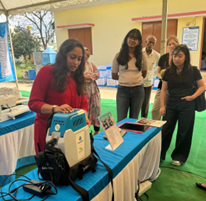
SELCO’s innovations in healthcare extend to cold chain solutions, such as solar-powered vaccine carriers that increase preservation times and significantly improve immunization coverage in remote communities. These carriers have extended vaccine duration from 4 to 12 hours, leading to higher rates of vaccination in isolated areas and enabling the providers who administer the doses by foot to take some rest between locations, significantly improving their wellbeing. Solar- powered maternal care kits and portable diagnostic devices further bring life-saving services closer to those who need them most, reducing logistical barriers.
Decarbonization + Development
SELCO’s work exemplifies that decarbonization and development can co-exist. Through a holistic and inclusive approach, the SELCO Foundation addresses inequities that hinder sustainable development. Their collaboration with financial institutions, microfinance groups, SHGs, and private sector donors ensures that renewable energy solutions are both affordable and accessible for these communities. These blended finance models help mitigate risks for both providers and users, fostering financial sustainability. Additionally, partnerships with local governments, NGOs, and community organizations bolster capacity building and ensure that solutions are locally owned and maintained. SELCO’s commitment to knowledge sharing through its Solutions Portal and collaborations with international bodies like the WHO and IRENA amplifies their global impact, enabling cross-boundary replication of best practices.
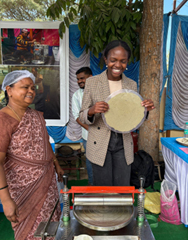
Despite operating with a lean team, SELCO achieves remarkable outcomes through ingenuity and collaboration. As one classmate remarked, SELCO embodies the spirit of “leapfrogging”: bypassing conventional development pathways to create sustainable, scalable solutions. By using DRE to boost productivity and enable access to critical services, SELCO uplifts communities with low-carbon intensity. Their work makes sustainable development in India feel possible and our visit made it tangible. SELCO’s approach serves as an example of inclusive climate action, proving that renewable energy can be transformative for economic development as well.

